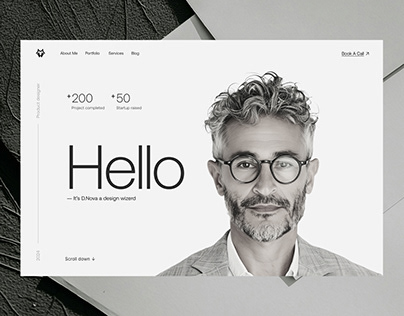Optimized Website Design Solutions for Enhanced Experience
Wiki Article
Top Tips for Developing an Impactful Web Site Style That Converts
In today's digital landscape, the importance of an impactful web site style can not be overemphasized, particularly when it pertains to transforming visitors into clients. To attain this, one need to consider a range of aspects, including comprehending the target market, focusing on customer experience, and maximizing for mobile platforms. Moreover, the calculated use engaging call-to-actions and a distinct aesthetic power structure plays a critical duty in leading users with their trip. As we check out these important elements, it becomes obvious that the success of your site depends upon more than just aesthetic appeal; it calls for a thoughtful method to style and functionality.
Understand Your Target Target Market
Comprehending your target market is basic to reliable site layout, as it lays the groundwork for producing an engaging customer experience. Identifying who your users are, including their demographics, choices, and behaviors, allows developers to tailor the site's content, layout, and functionality to meet particular requirements.Performing comprehensive market study is crucial in this procedure. Studies, interviews, and analytics can offer useful understandings right into individual expectations and discomfort factors. By assembling this information, designers can develop individual personalities that stand for various sections of the target market, guaranteeing that design choices are notified and pertinent.
Moreover, comprehending the target market helps in choosing proper design aspects such as color plans, typography, and imagery that resonate with individuals. A site that talks straight to its audience fosters a sense of connection and depend on, motivating longer check outs and higher conversion rates.
Inevitably, a user-centered method to web site layout not only enhances user complete satisfaction yet likewise sustains business objectives by driving involvement and commitment. By prioritizing the requirements and choices of the target audience, a web site can properly serve its function and attain desired results.
Prioritize User Experience
To improve the overall performance of a site, focusing on customer experience (UX) is necessary (Website Design). A well-designed UX ensures that site visitors can browse the website effortlessly, find details promptly, and involve with content meaningfully. This brings about raised customer complete satisfaction and greater conversion ratesBegin by applying intuitive navigation. Menus ought to be practically structured, allowing users to situate vital locations of the site with marginal effort. Uniformity in style aspects, such as color design and fonts, cultivates experience, which is essential for maintaining individual interaction.
Furthermore, consider the loading rate of your site. A delay of simply a few seconds can cause substantial drop-offs, as individuals are much less likely to wait for a slow-loading page. Simplifying photos and maximizing code can enhance performance and retain visitors.
Furthermore, clearness in material discussion is essential. Use succinct, interesting language and separate text with visuals to boost readability. By prioritizing user experience, you not just create an extra enjoyable setting for visitors but likewise enhance your brand's reputation. Inevitably, an emphasis on UX is an investment in the long-lasting success of your internet site.
Maximize for Mobile Gadgets
Optimizing for smart phones visit homepage is critical in today's electronic landscape, where an increasing variety of customers access sites with smartphones and tablets. A mobile-friendly design not only boosts user experience yet likewise plays a significant function in boosting online search engine positions. To attain this, it is important to adopt a responsive style that instantly changes to various display dimensions and alignments.
Filling rate is another important aspect; mobile users are commonly much less individual and anticipate fast accessibility to information. Maximize images and utilize web browser caching to enhance performance. Finally, examination your web site on multiple tools and screen resolutions to identify and fix any potential usability problems. By focusing on mobile optimization, you ensure that your site continues to be competitive and properly engages a wider audience.
Use Engaging Call-to-Actions
A web site's performance typically pivots on its capability to guide site visitors toward preferred activities, making engaging call-to-actions (CTAs) important elements of style. CTAs work as the crucial points that route users to involve with the website, whether that implies making an acquisition, registering for an e-newsletter, or downloading and install a source.To create effective CTAs, clarity is paramount. Use succinct language that clearly interacts the action you desire the customer to take.
In addition, think about making use of directional hints, such as arrowheads or pictures, to assist More hints users toward these buttons. By concentrating on these components, services can significantly enhance user involvement, driving conversions and ultimately attaining their website's objectives.
Emphasis on Visual Hierarchy
Effective internet site design depends greatly on a well-structured aesthetic pecking order that overviews users with web content seamlessly. By arranging components in a way that focuses on information, developers can improve user experience and assist in decision-making. This involves using dimension, shade, contrast, and spacing tactically to accentuate the most important parts of a website.company website Making use of larger font styles for headings and subheadings establishes a clear distinction in between various sections, allowing users to scan content effortlessly. In addition, employing contrasting colors for buttons and calls-to-action can catch individual attention and motivate communication. Whitespace is one more vital part; it stops clutter and allows individuals to focus on crucial messages without disturbances.
Images and graphics need to enhance the text while likewise sticking to the recognized hierarchy, strengthening the overall message (Website Design). Uniformity in style components, such as color design and typography, additional enhances the visual pecking order, making navigation user-friendly

Verdict
In conclusion, reliable site layout requires a thorough understanding of the target audience, prioritization of customer experience, and mobile optimization. Eventually, a well-executed site layout offers as an essential element in driving customer activities and achieving organization purposes.Report this wiki page